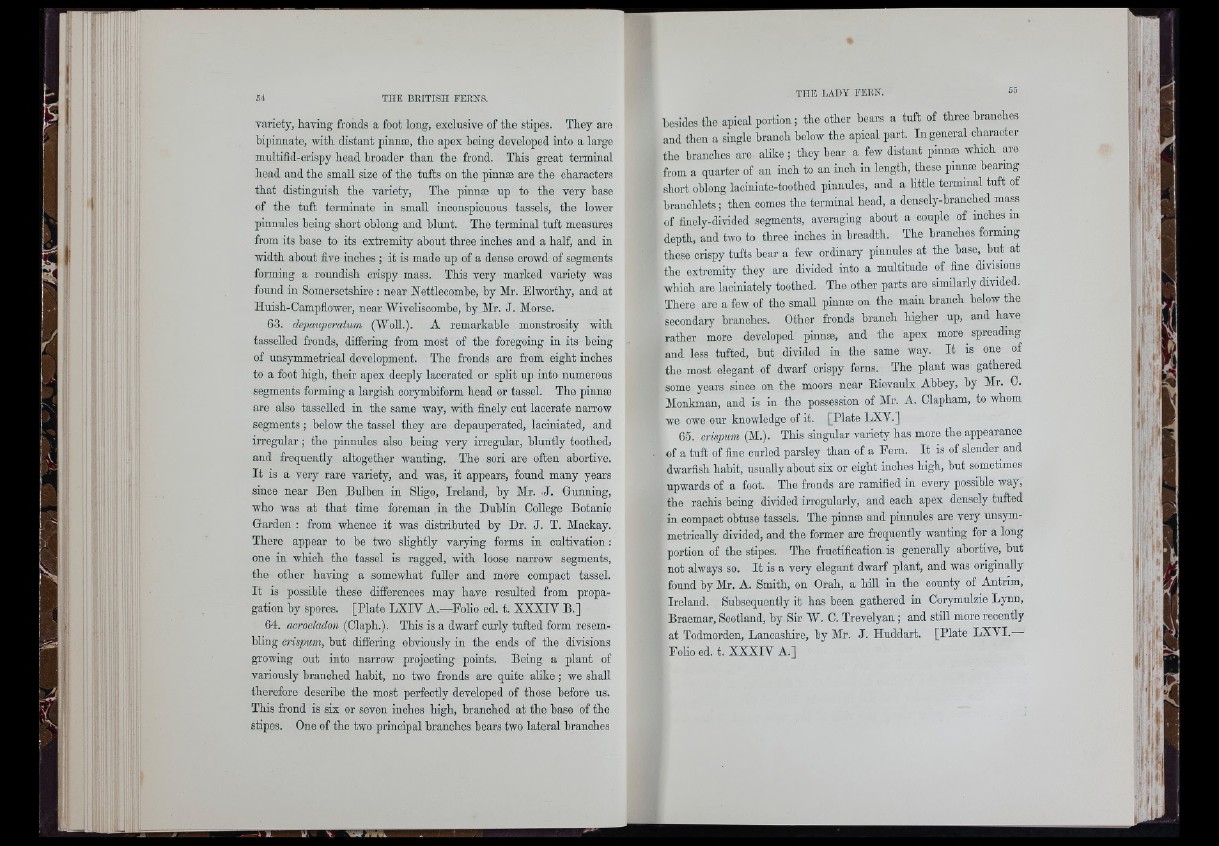
S i THE BRITISH FERNS.
variety, having fronds a foot long, exclusive of the stipes. They are
bipinnate, with distant pinnæ, the apex being developed into a largo
multifid-crispy head broader than the frond. This great terminal
head and the small size of the tufts on the pinnæ are the characters
that distinguish the variety. The pinnæ up to the very base
of the tuft terminate in small inconspicuous tassels, the lower
pinnules being short oblong and blunt. The terminal tuft measures
from its base to its extremity about three inches and a half, and in
width about five inches ; it is made up of a dense crowd of segments
forming a roundish crispy mass. This very marked variety was
found in Somersetshire : near Nettlecombe, by Mr. Elworthy, and at
Huish-Campflower, near Wivehsoombe, by Mr. J. Morse.
63. depauperatum (WolL). A remarkable monstrosity with
tasselled fronds, differing from most of the foregoing in its being
of unsymmetrioal development. The fronds are frorii eight inches
to a foot high, their apex deeply lacerated or split up into numerous
segments forming a largish oorymbiform head or tassel. The pinnæ
are also tasselled in the same way, with finely cut lacerate narrow
segments ; below the tassel they are depauperated, laoiniated, and
irregular ; the pinnules also being very irregular, bluntly toothed,
and frequently altogether wanting. The sori are often abortive.
It is a very rare variety, and was, it appears, found many years
since near Ben Bulben in Sligo, Ireland, by Mr. J. Gunning,
who was at that time foreman in the Dublin CoUege Botanic
Garden : from whence it was distributed by Dr. J. T. Mackay.
There appear to be two slightly varying forms in cultivation ;
one in which the tassel is ragged, with loose narrow segments,
the other having a somewhat fuller and more compact tassel.
It is possible tbese differences may have resulted from propagation
by spores. [Plate LXIV A.—Folio ed. t. XXXIV B.]
64. acrocladon (Claph.). This is a dwarf curly tufted form resembling
crispum, but differing obviously in tbe ends of the divisions
growing out into narrow projecting points. Being a plant of
variously branched habit, no two fronds are quite alike ; we shall
therefore describe the most perfectly developed of those before us.
This frond is six or seven inches high, branched at the base of the
stipes. One of the two principal branches bears two lateral branches
THE LADY FERN. 6 5
besides the apical portion; the other hears a tuft of three branches
and then a single branch below the apical part. In general character
the branches are alike ; they hear a few distant pmnoe which are
from a quarter of an inch to an inch in length, these pinnæ bearing
short oblong laciniate-toothed pinnules, and a little terminal tuft of
branchlets ; then comes the terminal head, a densely-branched mass
of finely-divided segments, averaging about a couple of inches in
depth, and two to throe inches in breadth. The branches forming
these crispy tufts bear a few ordinary pinnules at the base, but at
the extremity they are divided into a multitude of fine divisions
which are laciniately toothed. The other parts are similarly divided.
There are a few of the small pinnæ on the main branch below the
secondary branches. Other fronds branch higher up, and have
rather more developed pinuæ, and the apex more spreading
and less tufted, but divided iu tbe same way. It is one of
the most elegant of dwarf crispy ferns. The plant was gathered
some years since on the moors near Rievaulx Abbey, by Mr. C.
Monkman, and is in the possession of Mr. A. Clapham, to whom
we owe our knowledge of it. [Plate LXV.]
65. crispum (M.). This singular variety has more the appearance
of a tuft of fine curled parsley than of a Fern. It is of slender and
dwarfish habit, usually about six or eight inches high, but sometimes
upwards of a foot. The fronds are ramified in every possible way,
the raohis being divided irregularly, and each apex densely tufted
in compact obtuse tassels. The pinnæ and pinnules are very unsym-
metrioally divided, and the former are frequently wanting for a long
portion of the stipes. The fructification, is generally abortive, hut
not always so. It is a very elegant dwarf plant, and was originally
found by Mr. A. Smith, on Orah, a hill in the county of Antrim,
Ireland. Subsequently it has been gathered in Corymulzie Ljmn,
Braemar, Scotland, by Sir W. 0. Trevelyan ; and still more recently
at Todmorden, Lancashire, by Mr. J. Huddart. [Plate LXVI.—
Foho ed. t. XXXIV A.]
i] I
I ' l
■>?
y I i
Til
’ip
fH*
'l ( , i